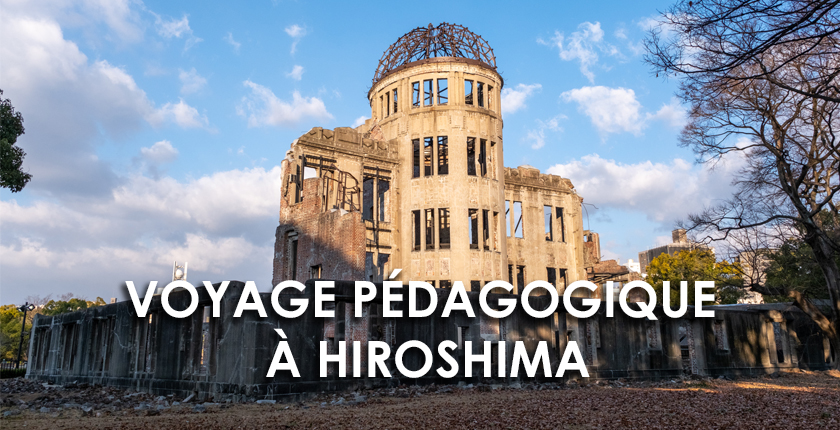Educational Trip to Hiroshima
- 7 February 2025
- Posted by: Mathieu Lecacheur
- Category: Secondary

An Immersion into the Heart of Japanese History and Culture
From January 29 to February 2, 2025, our high school students embarked on an exceptional educational journey to Hiroshima, Miyajima, and Himeji—an experience that left a lasting impression and deepened their understanding of Japanese history, culture, and resilience.
They were accompanied by their teachers: Ms. DOCO (Economics & Social Sciences, English), Ms. POPPESCHI (Science, Physics-Chemistry), Mr. LANNERS (History-Geography, Economics & Social Sciences, Geopolitics), and Mr. LECACHEUR (Communications).
Hiroshima: A Journey into Memory
The trip began in Hiroshima, a city that stands as a symbol of peace and remembrance. Students visited the Peace Memorial Park and the Atomic Bomb Dome, a UNESCO World Heritage site. The atmosphere at this emblematic location was deeply moving, prompting intense reflection on the consequences of war and the call for international reconciliation.
Their understanding of history was further enriched by a visit to the Hiroshima Peace Memorial Museum, where they encountered poignant testimonies and artifacts that had survived the August 6, 1945, tragedy. They also had the opportunity to engage with museum members who shared insights and firsthand accounts of the atomic bombing and its devastating effects.
In addition to these historical sites, students also explored the stunning Shukkei-en Garden, a tranquil oasis that provided a moment of contemplation amidst the weight of history.
Miyajima: A Spiritual Getaway
Following this historical immersion, the group traveled to Miyajima, the sacred island renowned for its natural and cultural beauty. The iconic floating Torii gate of Itsukushima Shrine, rising majestically from the Seto Inland Sea, offered students an unforgettable spectacle. Climbing Mount Misen rewarded them with breathtaking panoramic views of the sea and mountains. At the summit, they took a moment to appreciate Japan’s natural beauty and rich cultural heritage.
A Culinary and Cultural Experience
Back in Hiroshima, students visited the World Peace Memorial Cathedral (被昇天の聖母司教座聖堂), a symbolic site envisioned by Father Hugo Lassalle, himself an atomic bomb survivor. This cathedral, built in memory of the victims and dedicated to peace, embodies the hope for reconciliation and intercultural dialogue.
To end the day on a lighter note, students participated in a cooking workshop where they learned to prepare okonomiyaki, Hiroshima’s signature dish. This culinary experience added a festive and convivial touch to the evening.
Himeji: A Journey Through Time
The journey continued to Himeji, where students explored the magnificent Himeji Castle, one of Japan’s most beautiful and well-preserved castles. A UNESCO World Heritage site, this architectural masterpiece fascinated the students with its grandeur and historical significance. A guided tour provided deeper insight into Japan’s feudal period and military strategies.
Returning to Kyoto: New Perspectives
After a day rich in discoveries, the group departed from Himeji, arriving in Kyoto at 5:00 PM. This trip provided students with a unique opportunity for full immersion into Japanese history and culture, encouraging them to reflect on universal values such as peace, solidarity, and respect for traditions.
Through this adventure, our students not only expanded their historical and cultural knowledge but also strengthened their bonds, creating lifelong memories that will accompany them throughout their academic journey.
An unforgettable trip that demonstrates our institution’s commitment to providing students with educational experiences that shape them both academically and personally.
A Transformative Experience: Reflection and Commitment
This journey to Hiroshima was much more than just a school excursion. It offered students a rare opportunity to confront history in its most poignant and direct form. Standing before the Atomic Bomb Dome and visiting the Peace Memorial Museum, each student grasped the full magnitude of the tragedy, the suffering of civilian victims, and the lasting scars left by nuclear warfare. The emotions felt on-site transcended words and textbooks, leaving a lasting imprint on each participant and awakening a collective awareness of the devastating cost of war.
This experience extends beyond the places visited and the emotions felt in the moment. It opens the door to deeper reflection that will continue long after their return to Kyoto. The testimonies, discussions, and unforgettable images provide valuable material for teachers to enrich classroom discussions and deepen students’ understanding of historical issues.
